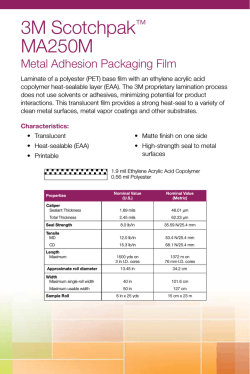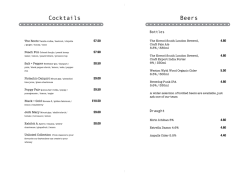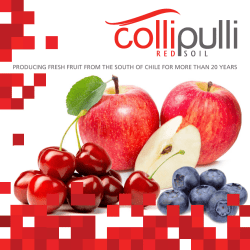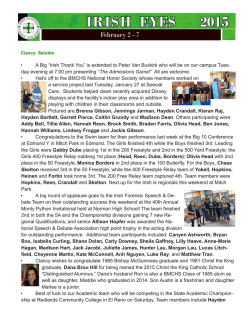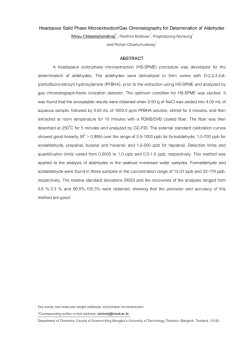
Two highly divergent alcohol dehydrogenases of melon
The definitive version is available at www.springerlink.com Two highly divergent alcohol dehydrogenases of melon exhibit fruit ripening-specific expression and distinct biochemical characteristics Daniel Manrı´quez Æ Islam El-Sharkawy Æ Francisco B. Flores Æ Fikri El-Yahyaoui Æ Farid Regad Æ Mondher Bouzayen Æ Alain Latche´ Æ Jean-Claude Pech Abstract Alcohol dehydrogenases (ADH) participate in the biosynthetic pathway of aroma volatiles in fruit by interconverting aldehydes to alcohols and providing substrates for the formation of esters. Two highly divergent ADH genes (15% identity at the amino acid level) of Cantaloupe Charentais melon (Cucumis melo var. Cantalupensis) have been isolated. Cm-ADH1 belongs to the medium-chain zinc-binding type of ADHs and is highly similar to all ADH genes expressed in fruit isolated so far. Cm-ADH2 belongs to the short-chain type of ADHs. The two encoded proteins are enzymatically active upon expression in yeast. Cm-ADH1 has strong preference for NAPDH as a co-factor, whereas Cm-ADH2 preferentially uses NADH. Both Cm-ADH proteins are much more active as reductases with Kms 10–20 times lower for the conversion of aldehydes to alcohols than for the dehydrogenation of alcohols to aldehydes. They both show strong preference for aliphatic aldehydes but Cm-ADH1 is capable of reducing branched aldehydes such as 3-methylbutyraldehyde, whereas Cm-ADH2 cannot. Both Cm-ADH genes are expressed specifically in fruit and up-regulated during ripening. Gene expression as well as total ADH activity are strongly inhibited in antisense ACC oxidase melons and in melon fruit treated with the ethylene antagonist 1-methyl- Daniel Manrı´quez and Islam El-Sharkawy contributed equally to the work. Accession numbers for Cm-ADH1 (ABC02081), and Cm-ADH2 (ABC02082). D. Manrı´quez Æ I. El-Sharkawy Æ F. B. Flores Æ F. El-Yahyaoui Æ F. Regad Æ M. Bouzayen Æ A. Latche´ Æ J.-C. Pech (&) UMR 990 INRA/INPT-ENSAT ‘‘Ge´nomique et Biotechnologie des Fruits’’, Av. de l’Agrobiopole, BP 32607, F-31326 Castanet-Tolosan Cedex, France e-mail: [email protected] cyclopropene (1-MCP), indicating a positive regulation by ethylene. These data suggest that each of the Cm-ADH protein plays a specific role in the regulation of aroma biosynthesis in melon fruit. Keywords Alcohol dehydrogenase/aldehyde reductase Æ Aroma volatiles Æ Ethylene Æ Fruit ripening Æ Mediumand short-chain ADH Æ Melon Introduction Alcohol dehydrogenases (ADH, EC 1.1.1.1) catalyze the reversible conversion of aldehydes to the corresponding alcohols. They have been involved in the stress response of plants, mainly in anaerobiosis where they are responsible for the production of ethanol. ADHs have also been implicated in the response to a wide range of other stresses, elicitors and abscisic acid (Matton et al. 1990; De Bruxelles et al. 1996; Peters and Frenkel 2004). However, ADH genes are also expressed in plant tissues in a developmentally-regulated manner, particularly during fruit ripening (Van der Straeten et al. 1991; Speirs et al. 1998, 2002; Echeverria et al. 2004). In tomato fruit, one of the two ADH genes, Le-ADH2, participates in the formation of flavor volatiles during fruit ripening. Over-expression of Le-ADH2 has led to improved flavor of the fruit by increasing the level of alcohols, particularly Z-3-hexenol (Speirs et al. 1998). In grapes, three ADH genes are expressed during fruit development. Vv-ADH1 and Vv-ADH3 transcripts accumulate transiently in young developing berry, while Vv-ADH2 transcripts strongly increase at the onset of ripening named ve´raison (Tesnie`re and Verrie`s 2000). Fruit-specific dehydrogenases so far characterized belong to the medium-size zinc-containing class (Chase 1999). Partial cDNA clones putatively encoding shortchain ADHs have been reported in tomato (Picton et al. 1993) and in pear (Fonseca et al. 2004). In melon, the step of conversion of aldehydes to alcohols is controlled by ethylene and is strongly inhibited by the ethylene antagonist 1-MCP and in fruit in which ethylene production has been suppressed by an antisense ACC oxidase gene (Flores et al. 2002). In the present study, two fruit-specific CmADH genes belonging to both the medium- and short-chain types have been isolated. After expression in yeast and purification, we have found that the two encoded enzymes preferentially work as aldehyde reductases and have specific substrates preferences. Materials and methods Plant material and postharvest treatments Wild-type (WT) and ACC oxidase antisense (AS) Charentais Cantaloupe melons (Cucumis melo var. Cantalupensis, Naud cv. Ve´drantais) were used (Ayub et al. 1996; Guis et al. 1997). They were grown on a trellis in a greenhouse under standard cultural practices for fertilization and pesticide treatments. Freshly opened female flowers were tagged on the day of hand-pollination to identify fruit of known age. Melons were harvested after 32, 35, 37, 39 and 42 days after pollination (DAP) and ethylene production measured immediately after harvest. Fruit were selected for homogenous ethylene production. Stages of ripening of WT fruit, and equivalent age for AS fruit, corresponded to mature green (32 DAP), onset of ripening (35 DAP), early climacteric (37 DAP), full climacteric (39 DAP) and late climacteric (42 DAP). Antisense fruits, harvested at 35 DAP, were exposed to 50 ll l)1 ethylene for 3 days. The ethylene inhibitor 1-MCP was applied at 35 DAP to WT fruit on the vine at l ll l)1 in 3-l jars for 3 days before harvesting with periodical flushing with air and re-injection of the inhibitor. Vegetative tissues (leaves, stems, seeds and roots) and flowers were collected from plants grown in a greenhouse. All plant material was frozen in liquid nitrogen and stored at )80C. RNA isolation Total RNA from fruit samples was extracted using the methods described by Boss et al. (1996). For leaf, stem, seed, root, and flower material, total RNA was extracted using RNeasy Plant Mini Kit following the manufacturer’s recommendations (Qiagen, Valencia, CA, USA). All RNA extracts were treated with DNAse I (Promega, Madison, WI, USA) and cleaned up by phenol–chloroform extraction. Isolation and in silico analysis of Cm-ADH sequences Cm-ADH1 and Cm-ADH2 have been isolated by PCR from a cDNA library of ripe melon. The SK primer (in Bluescript: 5¢-CGCTCTAGAACTAGTGGATCCC-3¢) was combined with the degenerated primers, Cm-ADH1 (F): 5¢TCTASTTTTAGCGWRTACACTGTT-3¢, Cm-ADH1 (R): 5¢-AAGTCCAAYAGMTCCAAGTCCAAA-3¢, CmADH2 (F): 5¢-CAGCCTTCAWSAGAAACCATG-3¢, and Cm-ADH2 (R): 5¢-AAGAGACTGTGCTCCATCAAC-3¢ designed from a conserved region among plants alcohol dehydrogenase. The isolated fragments were cloned using Qiagen PCR Cloningplus Kit (Qiagen, Valencia, CA, USA), sequenced and compared with database sequences using the BLAST program (Altschul et al. 1997). Extension of the partial cDNA clones was carried out using the 3¢- and 5¢-RACE kit (Invitrogen, Paisely, UK). First strand cDNA synthesis was carried out using 10 lg of total DNasetreated RNA in a 50 ll aliquot followed by PCR with specific Cm-ADH primers using 1 ll of cDNA. A high fidelity PCR system (BMB Indianapolis, IN, USA) was used with the following PCR parameters: 3 min template denaturation at 95C for one cycle, followed by 5 cycles at 95C (30 s), 58C (1 min), and 72C (1 min 30 s), then 25 cycles at 95C (30 s), 58C (1 min), and 72C (2 min) with a final 10 min extension step at 72C to isolate the full length Cm-ADH sequences. Alignments of the predicted protein sequences were performed with ClustalX (Thompson et al. 1997) and GENEDOC (Nicholas and Nicholas 1997). Phylogenetic analysis of ADH sequences was performed using the neighbor-joining method (Saitou and Nei 1987) of PHYLIP package (Felsenstein 1992). Bootstrapping was performed by resampling from the data 1000 times. Real time quantitative RT-PCR DNase-treated RNA (4 lg) was reverse transcribed in a total volume of 40-ll using Omniscript Reverse Transcription Kit (Qiagen, Valencia, CA, USA). Real-time quantitative PCR was performed using 100 ng of cDNA in a 20-ll reaction volume using SYBR GREEN PCR Master Mix (PE-Applied Biosystems, Foster City, CA, USA) on an ABI PRISM 7900HT sequence-detection system. PRIMER EXPRESS software (PE-Applied Biosystems) was used to design gene-specific primers (Table 1). For all the genes studied here, optimal primer concentration was 300 nM. RT-PCR conditions were as follow: 50C for 2 min, followed by 95C for 10 min, then 40 cycles of 95C for 15 s and 60C for 1 min. All RT-PCR experiments were run in triplicate with different cDNAs synthesized from three biological replicates. Samples were run in triplicate on each 96-well plate and were repeated at least two plates for each experiment. For each sample, a Ct (threshold sample) value was calculated from the amplification curves by selecting the optimal DRn (emission of reporter dye over starting background fluorescence) in the exponential portion of the amplification plot. Relative fold differences were calculated based on the comparative Ct method using the b-actin as an internal standard. A cDNA clone was isolated with homology to a b-actin sequence (AY859055). It was checked by Northern analysis (data not shown) that the bactin mRNA level was similar in all treatments. To demonstrate that the efficiencies of the different genes primers were approximately equal, the absolute value of the slope of log input amount versus D Ct was calculated for both the Cm-ADH and b-actin genes and was determined to be < 0.1. To determine relative fold differences for each sample in each experiment, the Ct value for both Cm-ADH genes was normalized to the Ct value for bactin and was calculated relative to a calibrator (seeds for Cm-ADH1, wild-type melon fruit treated 3 days with 1MCP for Cm-ADH2) using the formula 2)DDCt. Expression of Cm-ADH The two Cm-ADH cDNAs were cloned in the pYES2.1 TOPO-TA vector for regulated protein expression in yeast following the instructions provided by the manufacturer (Invitrogen, Paisely, UK). Auto-ligated construct was used as negative control. All the constructs were transformed into the Saccharomyces cerevisiae cell line INVSc1. The strain harboring the correct constructions were grown in selective medium (SC-U) with 2% galactose as inducer of the recombinant protein expression, at 30C and 250 rpm, according to manufacturer’s recommendations, until the OD600 of the culture reached ~4 U. Table 1 Real time quantitative PCR primers Name Oligonucleotide sequence Cm-actin-344 (F) Cm-actin-426 (R) Cm-ADH1-518 (F) Cm-ADH1-588 (R) Cm-ADH2-145 (F) Cm-ADH2-216 (R) 5¢-GTGATGGTGTGAGTCACACTGTTC-3¢ 5¢-ACGACCAGCAAGGTCCAAAC-3¢ 5¢-GTGTTCTTAGCTGCGGCATTT-3¢ 5¢-TTGACCCTTTTTAGGCTTTGCA-3¢ 5¢-GCGGAATCGTTAAAGGGTGTACT-3¢ 5¢-AGCCGCCTCTCTCTCTTCTTC-3¢ Purification of recombinant ADH and electrophoresis methods Cells were collected by centrifugation (1800 · g, 10 min at room temperature) from 150 ml of yeast cultures induced with galactose and resuspended in buffer A (50 mM sodium phosphate pH 7.5, 10% v/v glycerol, 0.3 M NaCl) containing 2 mM b-mercaptoethanol. The cells were mechanically ground in liquid nitrogen for 2 min and stored at )80C until needed. To extract the ADH enzyme, the powder was thawed and centrifuged at 45,000 · g for 20 min at 4C. The crude extract obtained was concentrated by addition of (NH4)2SO4 to 80% saturation. The suspension centrifuged at 45,000 · g for 20 min at 4C and the pellet suspended in 1 ml of tampon A and desalted in Sephadex G-25 columns equilibrated with buffer A (Amersham Biosciences, Chalfont Buckinghamshire, UK). The recombinant protein was purified by a metal affinity resin designed to purify polyhistidinetagged proteins (BD Talon metal affinity resin, BD Biosciences), according to the manufacturer’s protocol. Briefly, the enzyme was fixed to the resin in the presence of buffer A, and after removing the unbound proteins with several washes with the same buffer the recombinant protein was eluted with buffer A containing 150 mM imidazole. The extract was desalted in Sephadex G-25 equilibrated with buffer A. A second purification was performed with the metal affinity resin. The highly purified protein was quantified according to Bradford (1976) using bovine serum albumin as standard. Protein purity was verified by separation on SDS-PAGE (12% acrylamide gel) and staining with silver nitrate (Amersham Biosciences). ADH enzyme activity and kinetic parameters with recombinant proteins Reductase and dehydrogenase activities of ADH were evaluated by spectrophotometry according to Molina et al. (1987). Briefly, reductase activity was assayed in 1 ml total volume containing 100 ll of purified protein (1–2 lg), 5 mM aldehyde, 0.25 mM NADH or NADPH and adjusted to final volume with sodium phosphate 50 mM buffer (pH 5.8). Dehydrogenase activity was measured in the presence of 5 mM ethanol, 0.25 mM NAD or NADP and adjusted to final volume with glycine–NaOH buffer (pH 9.4). Different concentrations of NADH/NAD or NADPH/NADP (from 0.015 mM to 1 mM) or acetaldehyde/ethanol (from 0.15 mM to 10 mM) were used for kinetic parameters determinations. ADH enzyme activity assay of melon fruit crude protein One gram of mesocarp tissue was ground mechanically in the presence of 1 ml of extraction buffer (250 mM Tris/ HCl, pH 7.5, 0.1% Triton X-100 and 2 mM b-mercaptoethanol) in liquid nitrogen during 2 min and the protein crude extract was stored at )80C until needed. The protein extract was thawed in ice and centrifuged at 45,000 · g for 20 min at 4C. The supernatant phase was desalted using Sephadex G-25 columns (Amersham Biosciences) equilibrated with sodium phosphate 50 mM (pH 5.8). Total proteins were quantified according to Bradford (1976). ADH activity was measured as described above. Results and discussion Sequence analysis of Cm-ADH1 and Cm-ADH2 and predicted proteins Cm-ADH1 and Cm-ADH2 encode proteins of 379 and 266 residues, with the predicted molecular weight of 41.0 kDa and 29.0 kDa, and isoelectric points of 6.3 and 8.2, respectively. The Cm-ADH1 protein belongs to the highly conserved zinc-medium-chain ADHs sub-family (Chase 1999; Table 2 and Fig. 1). Many genes encoding proteins of this sub-family have been characterized in plants. In tomato, Le-ADH3a and Le-ADH3b are expressed in anthers (Ingersoll et al. 1994) and Le-ADH2 in ripening fruit (Longhurst et al. 1994) where it plays a role in the biosynthesis of aroma (Speirs et al. 1998). In grape, Vv-ADH2, is a ripening regulated gene (Sarni-Manchado et al. 1997; Tesnie`re and Verrie`s 2000). The alignment of Cm-ADH1 with sequences of different plant zinc-medium-chain ADH proteins shows the presence of a large number of conserved domains (Fig. 1), that are typical of this sub-family (Chase 1999). The identity at the amino acid level between Cm-ADH1 and other plants zinc-medium-chain ADHs sub-family is very high and ranges between 81 and 85% (Table 2). Many very well conserved amino acids that have been implicated in the fixation of zinc are present in CmADH1: Cys, His and Cys at the 50, 72 and 181 positions (Fig. 1) and four Cys at positions 102, 105, 108 and 116 (Eklund et al. 1976; Yokoyama and Harry 1993). The Asp in position 230, corresponding to Cm-ADH1 sequence has been described as implicated in the preference of NAD as co-factor in the dehydrogenase reaction (Eklund et al. 1976; Fan et al. 1991). Cm-ADH2 protein is a member of the short-chain ADH sub-family. Contrary to medium-chain ADHs, the percentage of identity at the amino acid level is highly variable ranging from 21 to 67% (Table 2). The highest Table 2 Amino acid sequence comparison between the peptides full length Cucumis melo (Cm-ADH1), Malus domestica (Md-ADH), Vitis vinifera (Vv-ADH2), Lycopersicon esculentum (Le-ADH2), Arabidopsis thaliana (At-ADH1), Solanum tuberosum (St-ADH3), Oryza sativa (OsADH2), Zea mays (Zm-ADH2), and Ametastegia formosa (Af-ADH2) zinc-medium-chain and Cucumis melo (Cm-ADH2), Lycopersicon esculentum (Le-ADHs), Solanum tuberosum (St-ADHs), Arabidopsis thaliana (At-ADH), Citrus sinencis (Cs-ADH), Ametastegia formosa (Af-ADH), Oryza sativa (Os-ADH), Zea mays (Zm-ADHs)and Datura stramonium (Ds-TRR2) short chain alcohol dehydrogenases proteins Protein Amino acid identity (%) Name Size Cm-ADH1 Cm-ADH2 Cm-ADH1 At-ADH1 Le-ADH2 Md-ADH Vv-ADH2 St-ADH3 Os-ADH2 Zm-ADH2 Af-ADH2 Cm-ADH2 Le-ADHs St-ADHs At-ADH Cs-ADH Af-ADH Os-ADH Zm-ADHs Ds-TRR2 379 379 380 380 380 380 379 379 383 266 266 266 266 266 266 277 253 260 – 85 83 83 83 83 81 81 84 15 16 16 12 15 14 13 10 12 15 14 12 14 14 11 12 11 13 – 64 64 53 67 59 50 24 21 For accession numbers see legends of Figs. 1 and 2 percentage of identity to Cm-ADH2 is for Cs-ADH of Citrus sinensis. Strikingly, genes of this sub-family have a number of conserved amino acids (around 40) well distributed all over the sequence, but very few conserved domains (Fig. 2). Persson et al. (1991) had highlighted few conserved elements of unknown function among plant short-chain dehydrogenases that are underlined in Fig. 2: (I) ALVTGG(S/T)RGIG, located at the N-terminal region, (II) ILVNNAG, (III) YxaxK and (IV) IRVNxVaP. However, alignment of Fig. 2 shows that none of these domains are well conserved except domains I and IV that show conservation of six amino acids out of 11 and five amino acids out of eight, respectively. Similarly, the three glycine residues at the N-terminal region that have been described by Jo¨rnvall et al. (1995) as implicated in binding NAD in Drosophila melanogaster ADH are all present in the DsTRR2 protein at positions 27, 31 and 35 (Fig. 2). However, only Gly 31 is conserved in all other plant ADH sequences shown in Fig. 2. The diversity in amino acid sequence of the short-chain ADHs sub-family can be related to a wide range of biological functions of such proteins that can use a wide range of substrates (Jo¨rnvall et al. 1995) such as tropinone (Nakajima et al. 1993) and 3-oxoacyl-acyl carrier protein (Klein et al. 1992) in higher plants. Cm-ADH1 At-ADH1 Vv-ADH2 Af-ADH2 Le-ADH2 St-ADH3 Md-ADH Os-ADH2 Zm-ADH2 : : : : : : : : : * 20 * 40 * 60 * 80 * 100 MS---TAGQVIKCKAAVAREAGKPLVIEKVEVAPPQANEVRLKILFTSLCHTDVYFWEAKGQTPLFPRIFGHKAGGIVESVGEGVKDLQ-PGDHVLPIFT MS---TTGQIIRCKAAVAWEAGKPLVIEEVEVAPPQKHEVRIKILFTSLCHTDVYFWEAKGQTPLFPRIFGHEAGGIVESVGEGVTDLQ-PGDHVLPIFT MS-S-TAGQVIRCKAAVAWEAGKPLVIEEVEVAPPQVMEVRLKILFTSLCHTDVYFWEAKGQTPLFPRIFGHEAGGIVESVGEGVTDLQ-PGDHVLPVFT MSISNTTGQIIRCKAAVAWEAGKPLVIEEVEVAPPQAMEVRVKILFTSLCHTDVYFWEAKGQTPLFPRIFGHEAGGIVESVGSGVTDLK-PGDHVLPMFT MS-T-TVGQVIRCKAAVAWEAGKPLVMEEVDVAPPQKMEVRLKILYTSLCHTDVYFWEAKGQNPVFPRILGHEAAGIVESVGEGVTDL-APGDHVLPVFT MS-T-TVGQVIRCKAAVAWEAGKPLVMEEVDVAPPQKMEVRLKILYTSLCHTDVYFWEAKGQNPVFPRILGHEAAGIVESVGEGVTEL-APGDHVLPVFT MS--NTAGQVIRCRAAVAWEAGKPLVIEEVEVAPPQANEVRIKILFTSLCHTDVYFWEAKGQNPLFPRIYGHEAGGIVESVGEGVTDLKA-GDHVLPVFT M---ATAGKVIKCKAAVAWEAGKPLSIEEVEVAPPQAMEVRVKILYTALCHTDVYFWEAKGQTPVFPRILGHEAGGIVESVGEGVTEL-APGDHVLPVFT M---ATAGKVIKCRAAVTWEAGKPLSIEEVEVAPPQAMEVRIKILYTALCHTDVYFWEAKGQTPVFPRILGHEAGGIVESVGEGVTDV-APGDHVLPVFT : : : : : : : : : 96 96 97 99 97 97 97 96 96 Cm-ADH1 At-ADH1 Vv-ADH2 Af-ADH2 Le-ADH2 St-ADH3 Md-ADH Os-ADH2 Zm-ADH2 : : : : : : : : : * 120 * 140 * 160 * 180 * 200 GECGDCSHCQSEESNMCDLLRINTDRGVMINDGKTRFSKNGQPIHHFVGTSTFSEYTVVHVGCLAKINPAAPLDKVCVLSCGISTGLGATLNVAKPKKGQ GECGECRHCHSEESNMCDLLRINTERGGMIHDGESRFSINGKPIYHFLGTSTFSEYTVVHSGQVAKINPDAPLDKVCIVSCGLSTGLGATLNVAKPKKGQ GECKECRHCKSEESNMCDLLRINTDRGVMLSDNKSRFSINGKPVYHFVGTSTFSEYTVIHVGCVAKINPAAPLDKVCVLSCGISTGLGATLNVAKPSKGS GECKDCAHCKSEESNMCDLLRINTDRGVMLNDGQSRFSINGKPIYHFVGTSTFSEYTVVHVGCLAKINPAAPLDKVCILSCGISTGLGAALNVAKPKQGS GECKDCAHCKSEESNMCSLLRINTDRGVMLNDGKSRFSINGNPIYHFVGTSTFSEYTVVHVGCVAKINPLAPLDKVCVLSCGISTGLGASLNVAKPTKGS GECKDCAHCKSEESNMCSLLRINTDRGVMINDGQSRFSINGKPIYHFVGTSTFSEYTVVHVGCVAKINPLAPLDKVCVLSCGISTGLGATLNVAKPTKGS GECKDCAHCKSEESNMCDLLRINTDRGVMLSDGKSRFSIKGKPIYHFVGTSTFSEYTVVHVGCLAKINPSAPLDKVCLLSCGISTGLGATLNVAKPKKGS GECKECDHCKSEESNMCDLLRINVDRGVMIGDGKSRFTIKGKPIFHFVGTSTFSEYTVIHVGCLAKINPEAPLDKVCILSCGFSTGFGATVNVAKPKKGQ GECKECAHCKSEESNMCDLLRINVDRGVMIGDGKSRFTISGQPIFHFVGTSTFSEYTVIHVGCLAKINPEAPLDKVCILSCGISTGLGATLNVAKPAKGS : : : : : : : : : 196 196 197 199 197 197 197 196 196 Cm-ADH1 At-ADH1 Vv-ADH2 Af-ADH2 Le-ADH2 St-ADH3 Md-ADH Os-ADH2 Zm-ADH2 : : : : : : : : : : : : : : : : : : 294 294 295 297 295 295 295 294 294 Cm-ADH1 At-ADH1 Vv-ADH2 Af-ADH2 Le-ADH2 St-ADH3 Md-ADH Os-ADH2 Zm-ADH2 : : : : : : : : : * 220 * 240 * 260 * 280 * 300 SVAIFGLGVVGLAAAEGARIAGASRIIGVDLNPA--RFEEAKKFGCNEFVNPKDHNKPVQEVIAEMTNGGVDRSVECTGSIQAMIAAFECVHDGWGVAVL SVAIFGLGAVGLGAAEGARIAGASRIIGVDFN--SKRFDQAKEFGVTECVNPKDHDKPIQQVIAEMTDGGVDRSVECTGSVQAMIQAFECVHDGWGVAVL SIAIFGLGAVGLAAAEGARIAGAARIIGIDLNP--KRFNDAKKFGVTEFLNPKDHDKPIQEVIAEMTDGGVDRSVECTGNVNAMISAFECVHDGWGVAVL TVAVFGLGAVGLAACEGARIAGAKRIIGVDLN--SNRFNEAKNFGVTDFVNPKDHDKPVQEVLAEMTDGGVDRSIECTGSVAAMISAFECVHDGWGVAVL SVAIFGLGAVGLAAAEGARIAGASRIIGVDLN-AS-RFEQAKKFGVTEFVNPKDYSKPVQEVIAEMTDGGVDRSVECTGHIDAMISAFECVHDGWGVAVL SVAIFGLGAVGLAAAEGARIAGASRIIGVDLN-AS-RFEQAKKFGVTEFVNPKDYSKPVQEVIAEMTDGGVDRSVECTGHIDAMISAFECVHDGWGVAVL TVAVFGLGAVGLAAAEGARLSGASRIIGVDLH--SDRFEEAKKFGVTEFVNPKAHEKPVQEVIAELTNRGVDRSIECTGSTEAMISAFECVHDGWGVAVL TVAIFGLGAVGLAAMEGARLSGASRIIGVDLNPA--KFEQAKKFGCTDFVNPKDHSKPVHEVLIEMTNGGLDRAVECTGNINAMISCFECVHDGWGVAVL TVAIFGLGAVGLAAMEGARLAGASRIIGVDINPA--KYEQAKKFGCTEFVNPKDHDKPVQEVLIELTNGGVDRSVECTGNVNAMISAFECVHDGWGVAVL • * 320 * 340 * 360 * 380 VGVPNKDDAFKTHPMNFLNERTLKGTFFGNYKPRTDIPGVVEKYLSKELELEKFITHTVSFSEINKAFDYMLKGESIRCIIRMDN : 379 VGVPSKDDAFKTHPMNFLNERTLKGTFFGNYKPKTDIPGVVEKYMNKELELEKFITHTVPFSEINKAFDYMLKGESIRCIITMGA : 379 VGVPNKDDSFKTHPVNLLNERTLKGTFFGNYKPRSDLPSVVEKYMNKELEVEKFITHEVPFAEINKAFEYMLSGDGLRCIIRMDA : 380 VGVPNKDDAFKTHPMNLLNERTLKGTFFGNYKPRSDIPSVVEKYMNKELELEKFITHEVPFSEINKAFEYMLQGKSIRCIIRMEA : 382 VGVPHKEAVFKTHPLNFLNERTLKGTFFGNYKPRSDIPCVVEKYMNKELELEKFITHTLPFAEINKAFDLMLKGEGLRCIITMAD : 380 VGVPHKEAVFKTHPMNFLNERTLKGTFFGNYKPRSDIPSVVEKYMNKELELEKFITHTLPFAEINKAFDLMLKGEGLRCIITMED : 380 VGVPHKDAVFKTHPVNFLNERTLKGTFFGNYKTRTDIPSVVEKYMNKELELEKFITHKVPFSEINKAFEYMLKGEGLRCIIRMEE : 380 VGVPTKDDVFKTHPMNFLNEKTLKGTFFGNYKPRTDLPNVVELYMKKELELEKFITHSVPFSEINTAFDLMLKGESLRCVMRMDE : 379 VGVPHKDDQFKTHPMNFLSEKTLKGTFFGNYKPRTDLPNVVEMYMKKELELEKFITHSVPFSEINTAFDLMLKGESLRCIMRMED : 379 Fig. 1 Amino acid sequence alignment of Cucumis melo Cm-ADH1 (ABC02081a) with closely related sequences Malus domestica Md-ADH (CAA88271a), Vitis vinifera Vv-ADH2 (AAL55726a), Lycopersicon esculentum Le-ADH2 (CAA54450 a), Arabidopsis thaliana At-ADH1 (AAK73970a), Solanum tuberosum St-ADH3 (AAA33808a), Oryza sativa Os-ADH2 (AAF34412a), Zea mays ZmADH2 (CAA26001a) and Ametastegia formosa Af-ADH2 (TC9383b) using ClustalX program. Conserved residues are shaded in black. Dark grey shading indicates similar residues in seven out of nine of the sequences and clear grey shading indicates similar residues in five out of nine of the sequences. The black arrows represent the amino acids that have been implicated in the fixation of zinc (Eklund et al. 1976; Yokoyama and Harry 1993). The grey circle represents the Asp that has been described as implicated in the preference of NAD as co-factor in the dehydrogenase reaction (Eklund et al. 1976; Fan et al. 1991). The letters following the accession numbers in the legend of the figure indicate the source database: (a) GenBank and (b) TIGR In order to determine the phylogenetic position of the melon ADH genes isolated in this study, a phylogenetic tree was contructed by employing a data set including some of the previously published medium- (Fig. 3A) and short-chain ADHs (Fig. 3B) from both monocots and dicots. The resulting ADH tree roughly consisted in two monophyletic groups (‘‘Clade 1’’ and ‘‘Clade 2’’) in both A and B sub-families (Fig. 3). Clade 1A and 1B contain ADH genes from dicots only including melon ADHs, while Clade 2A and 2B contain ADH genes from both dicots and monocots. In medium-chain ADHs (Fig. 3A), proteins show a very low divergence in accordance with the sequence alignments comparisons of Fig. 1. The closest neighbor for Cm-ADH1 is Arabidopsis thaliana ADH1. In contrast, short-chain ADHs show a high level of divergence (Fig. 3B). Expression of Cm-ADH1 and Cm-ADH2 genes Real time PCR analysis indicated that the two Cm-ADH genes studied here are specifically expressed in fruit. Vegetative tissues (leaves, stems, seeds, roots) and flowers exhibited no or very low expression (Fig. 4) even when treated with ethylene. The pattern of changes in transcript levels during fruit ripening was similar for the two CmADH genes with transient and sharp increase at 39 days when ethylene production was maximum (Fig. 4). Both genes exhibited very low expression before and after the peak. In AS melon fruit where ethylene was strongly suppressed by antisense ACO mRNA or in WT fruit treated with the ethylene antagonist 1-MCP (for 3 days before harvest at 35 DAP) the transcript levels of both genes were almost undetectable (Fig. 4). However, exposure of AS Le-ADHs St-ADHs Af-ADH Cs-ADH Cm-ADH2 At-ADH Os-ADH Zm-ADHs Ds-TRR2 : : : : : : : : : * 20 * 40 * 60 * 80 * 100 ME-----NP----G-----KKVLLT--SN-GDEICNNIAYHLAQRGCQLVLMGNER-QLKSVAEN-IKQSL--KGSV-AV--EVVGLDMTE-DRETAFDE ME-----NH----G-----KKVLLT--SN-GDDICNNIAYHLAQRGCQLVLMGNEH-QLKSVAEN-IKQSL--KGSV-AI--EVVGLDMTE-DRETAFDE M--G---S-SP--------KKVLIT--SN-GDNISLNIAYHLSKRGCRLVLMGEENC-IKKIVEK-ING-LQ-KG-VYEIG--IVAVDM-EADKEADFDD ME-----NQ---------AKRVLLT--SD-GDEISKNIAFHLAKRGCRLVLVGNERR-LSSVAEKMM-GSL--KGGQ-PV--EVVGLDMEE-DREGAFDD ME-G----AT---------KNVLLS--S-GGDEISKNLALHLARRGCRLVLIGNECV-LQSMS-KMIAESL--KG-VLPI--EVVGLDMEEE-REAAFDE ME-----N--P-------AKRVLMT--SN-GDEVSRNIAFHLAKHGCKLVMMGNEGS-LRSIV-DKIRDSIE--GAF-P--ADVIALDM-ESDSEVAFHA M-L----NESMGEGDAAYAKRVLLTAA---GDDVSRGIASTLATHGCRLVLVGDEGA-LAGTAEEARRGGG---GGD-AV-A-VVGLDLHGCD-EAAVDA MDVKCRR---L-EG-----KVAIVTA-STMG--IGLAIAERLGLEGAAVVIS-S-RKQ-KNVNE-AVEG-LRAKG-ITAVGA-V--CHV-S-DAQQ-RKS M-AG-RWN--L-EG-----CTALVTGGSR-G--IGYGIVEELASLGASV-YTCS-RNQ-KELN-DCLTQW-RSKG-FK-VEASV--CDLSSR-SE--RQE : : : : : : : : : * 120 * 140 * 160 * 180 * 200 AVDK-AWKIF-GKLDALVHCYAYEG-KMQDP--LQLIDDEFKKIVKINFM-AGW-YLLKC-IGNRMRD-GKS--GGSIVFMTSII-GAERGIY---QGAA AVDK-AWKIF-GKLDSLVHCYAYEG-KMQDP--LQLIDDEFKKIVKINFM-AGW-YLLKC-IGNRMRDS-KS--GGSIVFMTSII-GAERGIY---QGAA AVNK-AWRIL-GNIDSLVHCYDYEG-KMQDP--LHLVEDELKKIVKINFL-ASW-FLLK-AVGKRMRDFG-A--GGSIIFMNSIM-GSERGLY-S--GSA AVHK-ACQIL-GNLDAFVHCYTYEG-KMQDP--LQVGEDEFKKLVKINFV-APW-FLLK-AVGRRMKES-KA--GGSIVFLTSII-GAERGLY-P--GAA AVNR-ACSVL-GTLDAFVHAYSYEGP-IQDA--LQLSEEEFKKIVKINLM-ASW-FLMK-AVCRRMRDQ-KS--GGSVIFLTTLI-GAERGLY-P--GGA AVQK-AWELS-GHFDAFLNSYTYQG-KVQD--ILQVSQDEFHRITKINL-TAPW-FLLK-AVATRMKDHG-S--GGSIVFMATIASG-ERALY-P--GAD AVGT-AWRCFDG-LDAMVNCYSYEGE-VQDC--LNISEDEFKKTMKANVMT-PW-FLVK-AIAKRLRDSE-SSCGGSVVFLTQII-GAERGLY-P--GAA LIET-AVKSF-GHIDILVSNAAAN-PSV-DS-ILEMKESVLDKLWDIN-VKASI-LLIQDA-APHLRK-G-S----SVIIISSIA-G-----YNPEQGLT LMNTVANH-FHGKLNILVNNAGIVIYK-E-AKDYTV-EDYSLIMS-INFEAA-YHLSVL-AH-PFLKASER---GNVV-FISSV-SGAL-AV--PYE-A- : : : : : : : : : * 220 * 240 * 260 * 280 * 300 AYG-SCA--AGIQQLVRLSAIELGKYQ---IRVNGILRG-LHLED-EFPLSV-GKE--RAVK-LTK--E-AAPLNRWLD-PKK-DLASTVIYLISDD-SR AYG-SCA--AGIQQLVRLSAIELGKHQ---IRVNGIMRG-LHLED-EFPLSV-GKE--RAEK-LTK--E-AAPLNRWLDA-KK-DLASTVIYLISDD-SR AYG-SCM--AGVQQLVRASAMEIGKHQ---IRVNAIARG-LHLQD-EYVLS-EG-QE-KA-KKLTK--E-VMPLLRWLD-VKN-DLASTVIYLISDD-SH AYGA-CA--ASIHQLVRTAAMEIGKH-K--IRVNGIARG-LHLQD-EYPIAV-G-QE-RAVK-LVK--E-AAPLHRWLD-VKN-DLASTVIYLISDG-SR AYG-SCS--AGLQQLARTSALDVGKY-K--IRVNAIARG-LHLDNG-YPVSV-GKE--RAKK-LVK--D-AAKLERWLD-VKD-DLASTVIYLISDG-SR AY-AS-TSAA-IHQLVRASAMSLGKH-K--IRVNMISRG-LHLDD-EYTASV-GRD--RAQK-LVK--D-AAPLGQWLN-P-ETDLYSTVIYLISDG-SR AYG-T-SLGA-IHQLVRLSAMELGKH-K--MRVNAVCRG-LHLGDR-FPVWV-GKE--KAEKA-TG--E-VMPLRRWLD-P-EKDVASTVLYLVGDE-SR MYGVTKT--A-LFGLTK--ALA-GEMGPD-TRVNCIAPGFVPTRFASF-LT-EN-ETIRKE--LN---ERTK-LKR-LGTV-E-DMAAAAAFLASDDASVYGATK--GA-MDQLTR--CLA-FEWAKDNIRVNGVGPGVIATSLVE--MTIQDPEQ-K-E-NLNKLIDRCA-LRR-MGEPKE--LAAMVAFLCFPAAS- : : : : : : : : : 75 75 75 75 75 75 84 76 75 : : : : : : : : : 160 160 160 160 160 160 171 156 157 : : : : : : : : : 242 242 242 242 242 242 253 236 241 I Le-ADHs St-ADHs Af-ADH Cs-ADH Cm-ADH2 At-ADH Os-ADH Zm-ADHs Ds-TRR2 II Le-ADHs St-ADHs Af-ADH Cs-ADH Cm-ADH2 At-ADH Os-ADH Zm-ADHs Ds-TRR2 IV III Le-ADHs St-ADHs Af-ADH Cs-ADH Cm-ADH2 At-ADH Os-ADH Zm-ADHs Ds-TRR2 : : : : : : : : : * 320 YMTGTSIFVDGA-QS-LVRPRMRSYM YMTGTSIFVDGA-QS-LVRPRMRSYM YMTGTTIFVDGA-QS-IVRPRMRSYM YMTGTTIYVDGA-QS-ITRPRMRSYM YMTGTTIFVDGA-QS-LVRPRMRSYM FMTGTTVLVDGA-QS-LTRPRLKSYM YMTGSTIFVDGA-QS-IVRPRMRSFM YITAETIVVAGGVQSRL--------YVTGQIIYVDGGL---M---ANCGF- : : : : : : : : : 266 266 266 266 266 266 277 253 260 Fig. 2 Amino acid sequence alignment of Cucumis melo Cm-ADH2 (ABC02082a) with closely related full length sequences of Arabidopsis thaliana At-ADH (AAM65725a), Citrus sinensis Cs-ADH (CX049468a), Ametastegia formosa Af-ADH (TC19306b), Oryza sativa Os-ADH (AAO37953a), Datura stramonium Ds-TRR2 (AAA33282a) and ESTs from Zea mays Zm-ADHs (AY105662a), Lycopersicon esculentum Le-ADHs (U213436c) and Solanum tuberosum St-ADHs (U271654c), using ClustalX program. Conserved residues are shaded in black. Dark grey shading indicates similar residues in seven out of nine of the sequences and clear grey shading indicates similar residues in five out of nine of the sequences. The underlines represent the conserved amino acids in short-chain ADHs (Persson et al. 1991). The black arrow represents Gly 31 that has been described as implicated in binding NAD (Jo¨rnvall et al. 1995). The letters following the accession numbers in the legend of the figure indicate the source database: (a) GenBank, (b) TIGR and (c) SGN fruit to ethylene resulted in stimulation of gene expression although the levels of mRNA never reached the values of WT fruit at the peak (Fig. 4). Our data indicate that ethylene is a major regulator of Cm-ADH1 and Cm-ADH2 transcript levels. Partial involvement of ethylene in hypoxic induction of Arabidopsis thaliana ADH1 in seedlings has been reported (Peng et al. 2001). In tomato, Van der Straeten et al. (1991) showed that the accumulation of tomato ADH mRNA was related to fruit ripening, with 50 times higher mRNA accumulation in ripe as compared to green fruit. Expression of Le-ADH2 is strongly induced during fruit ripening (Chen and Chase 1993). However, the induction of expression during ripening is not related to hypoxic conditions in the fruit. Exogenous ethylene stimulated expression, but this appeared as to be indirect because it requires more than 24 h after ethylene treatment (Chen and Chase 1993). Ethylene was also concluded not to be involved in hypoxic induction of ADH in maize and rice (Morrell and Greenway 1989). In tomato, a partial cDNA clone showing homology to short-chain ADHs is expressed during ripening and expression was greatly reduced in the rin mutant (Picton et al. 1993). In pear, the expression of an EST putatively encoding a short-chain ADH increased during ripening in parallel to the expression of the ACO gene encoding for a key enzyme of ethylene biosynthesis (Fonseca et al. 2004). In grape, a non-climacteric fruit, ethylene stimulates the expression of Vv-ADH2 a gene essentially expressed at ve´raison, the onset of ripening (Tesnie`re and Verrie`s 2000). Application of 1-MCP an antagonist of ethylene in berries results in the reduction of the expression of Vv-ADH2 mRNA (Tesnie`re et al. 2004). In addition, cell cultures of Vitis vinifera treated with 2-chloro ethyl phosphonic acid (CEPA), an ethylene Alcohol dehydrogenase activity of Cm-ADH1 and Cm-ADH2 recombinant proteins towards various substrates in vitro Fig. 3 Neighbor-joining bootstrap phylogenetic tree of the two CmADH with ADHs sequences belonging to the medium-chain zincbinding type (At-ADH1, Vv-ADH2, Af-ADH2, Le-ADH2, St-ADH3, Fa-ADH, Md-ADH, Os-ADH2 and Zm-ADH2) and short-chain type of ADHs (At-ADH, Cs-ADH, Af-ADH, Os-ADH, Ds-TRR2, ZmADHs, Le-ADHs, and St-ADHs). The percent bootstrap support for 1000 replicates is shown below each node. Amino acid sequences were aligned using Clustal W. Fragaria · ananossa ADH (Fa-ADH) accession number is CAA33613 (GenBank) regenerating compound, showed a stimulation of the expression of Vv-ADH2 mRNA as compared to control cells (Tesnie`re et al. 2004). Furthermore, the promoter of the Vv-ADH2 gene contains putative ethylene responsive element (ERE) motifs that are probably involved in responsiveness to ethylene treatment (Verrie`s et al. 2004). Because endogenous ADH activity was present in yeast, the biochemical characterization of the recombinant CmADH proteins has been performed using a highly purified protein after two successive purifications steps by affinity column chromatography. As aldehyde reductases, the two recombinant enzymes showed a preference for aliphatic aldehydes, mainly acetaldehyde (Table 3). Using acetaldehyde as substrate, Cm-ADH1 shows 4.5 times more activity in the presence of NADPH than in the presence of NADH (Table 3). This was similar to the activity of VvADH2 and Vv-ADH3 that have also strong preference for NADPH (Tesnie`re et al. 2004). On the contrary, CmADH2 had strong preference for NADH, with an activity of reduction of acetaldehyde that was about six times higher than with NADPH. Beside aliphatic aldehydes, Cm-ADH1 utilized also branched aldehydes as 2 and 3-methylbutyraldehyde, 2-methylproponladehyde and aromatic aldehydes such as benzaldehyde, but the activity for this type of substrates is approximately 4–70 times lower than with acetaldehyde both in the presence of NADPH or NADH (Table 3). Cm-ADH2 used almost exclusively aliphatic aldehydes. Activity with branched or aromatic aldehydes was between 20 and 40 times lower in the presence of NADH as a co-factor and not detectable or at trace levels in the presence of NADPH as a co-factor (Table 3). The activity of Cm-ADH1 and Cm-ADH2 towards the oxidation of ethanol was strictly NAD dependant with activities of 8865 lmol mg prot)1 min)1 and 441 lmol mg prot)1 min)1, respectively. No activity could be detected in the presence of NADP. These results are in agreement with the presence, in Cm-ADH1, of an Asp residue in position 230 (Fig. 1) which is implicated in the fixation of NAD (Eklund et al. 1976; Fan et al. 1991). Information on the NAD binding site in short-chain ADHs is lacking. An Asp residue at the position 130 present in all ADH sequences aligned in Fig. 2, except Ds-TRR2, could correspond to the Asp residue involved in NAD binding. Kinetic parameters of recombinant Cm-ADHs proteins The kinetic parameters were determined using the preferential substrate and co-factor for the two enzymes operating as either reductases (acetaldehyde/NADPH for Cm-ADH1 or acetaldehyde/NADH for Cm-ADH2) or oxidases (ethanol/NAD for both enzymes). Table 4 shows that Cm-ADH1 had a Km for acetaldehyde which was 10 times lower than the Km for ethanol (0.25 mM as compared with 2.5 mM). The respective Vmax were of 2500 lmol mg prot)1 min)1 and 5000 lmol mg prot)1 min)1. The Km for Fig. 4 Ethylene production and Cm-ADH genes expression during fruit ripening and various organs of melon. (A) ethylene production, (B) and (C) levels of Cm-ADHs transcripts assessed by real time quantitative PCR. The experiments were carried out in triplicate. The X-axis represents various organs of melon (leaf, seed, stem, root) and flower; wild-type (WT) and antisense (AS) melon fruit at different days after pollination; WT (35 DAP) fruit exposed to 1-MCP (1 ll l)1) for 3 days, and AS fruit treated with ethylene (50 ll l)1) for 3 days. DDCt in the Y-axis of each figure refers to the fold difference in CmADH1 and Cm-ADH2 expression relative to seeds and to wild-type melon fruit treated 3 days with 1-MCP, respectively NADPH was about 3.5 times lower than for NAD (0.07 mM and 0.25 mM, respectively). The Cm-ADH2 protein had a Km for acetaldehyde which was about 18 times lower that for ethanol (0.24 mM and 4.52 mM). The corresponding Vmax were 588.2 lmol mg prot)1 min)1 and 370.4 lmol mg prot)1 min)1, respectively (Table 4). The Km for NADH was lower (0.02 mM) than for NAD (0.37 mM). When compared with data obtained for other ADHs, it appeared that the Km values for acetaldehyde of Cm-ADH1 and Cm-ADH2 (0.25 mM and 0.24 mM) were similar with the Km for acetaldehyde of the grape VvADH2 (0.45 mM) reported by Tesnie`re et al. (2004). However, the Vmax for acetaldehyde of Vv-ADH2 (300 lmol mg prot)1 min)1) was closer to Cm-ADH2 (588.2 lmol mg prot)1 min)1) than to Cm-ADH1 (2500 lmol mg prot)1 min)1). Low Km values for the cofactors have also been observed by Tesnie`re et al. (2004) for the recombinant proteins of grape, Vv-ADH2 and VvADH3, (0.02 mM and 0.04 mM, respectively). In addition, Salas and Sanchez (1998) have also described a very low Km for NADPH of an ADH purified from olive fruit. The lower Km for the acetaldehyde substrate of the two melon ADHs as compared to ethanol suggest that these two enzymes operate preferentially as reductases of aldehydes into alcohols rather than oxidases of alcohols into aldehydes. This observation is confirmed by the catalytic efficiency (corresponding to the kcat/Km ratio) which is 5-fold (Cm-ADH1) to 30-fold (Cm-ADH2) higher for acetaldehyde as compared to ethanol (Table 4). Although these data have been obtained with recombinant proteins, it can be assumed, however, that the preferential production of alcohols also occurs in the fruit in vivo. Alcohols such as ethanol, butanol, hexanol and 3-methybutanol are indeed substrates for alcohol acyl-transferases (AAT) implicated in the aroma biosynthesis in melon fruit (Yahyaoui et al. 2002; El-Sharkawy et al. 2005). Therefore, the mode of action of the two ADHs of melon supports a role for the two enzymes in the biosynthesis of aroma in melon fruit. Table 3 Activities of purified recombinant Cm-ADH1 and Cm-ADH2 proteins towards different aldehydes (5 mM) and NADH or NADPH (0.25 mM) Aldehydes Cm-ADH1 Cm-ADH2 NADH NADPH NADH NADPH 474 – 96 2216 – 228 487 – 38 80 – 6 316 – 41 980 – 33 273 – 41 60 – 8 285 – 56 978 – 63 241 – 36 57 – 1 24 – 13 41 – 5 7–1 ND 129 – 30 483 – 32 14 – 3 TR 76 – 6 88 – 11 16 – 2 TR 15 – 2 30 – 2 6–2 ND Activity is expressed in lmol mg prot)1 min)1 as the mean – SE of three replications However, none of the melon recombinant ADHs were capable of converting different ketones such as acetone, 3-pentanone, 1-pentene-3-one, b-ionone and 6-methyl-5heptene-2-one into the corresponding alcohols (data not shown) while some of these compounds are present in aroma volatiles of melon (Aubert and Bourger 2004). Since some short-chain ADHs characterized in plants are capable of reducing ketones (Chase 1999), it can be concluded that other ADH proteins may, therefore, be present and expressed in melon for the synthesis of such compounds. ADH activity in fruit ADH activity was measured in fruit extracts of untransformed melon (WT) and antisense ACC oxidase melon (AS) with acetaldehyde as a substrate in the presence of Table 4 Kinetic parameters of purified recombinant Cm-ADH1 and Cm-ADH2 proteins Vmax (lmol mg prot)1 min)1) Km (mM) Cm-ADH1 Acetaldehyde NADPH Ethanol NAD NADPH (0.25 mM) Acetaldehyde (1.25 mM) NAD (0.25 mM) Ethanol (20 mM) 2500.0 3333.3 5000 12,500 0.25 0.07 2.5 0.25 Cm-ADH2 Acetaldehyde NADH Ethanol NAD NADH (0.125 mM) Acetaldehyde (1.25 mM) NAD (0.125 mM) Ethanol (20 mM) 588.2 555.6 370.4 526.3 0.24 0.02 4.52 0.37 120 ADH activity (µmol.mg prot-1.min-1) Fig. 5 ADH activity in WT and AS fruit (42 DAP). Enzyme activity was measured with 5 mM acetaldehyde as a substrate in the presence of 0.25 mM NADH or NADPH. Activity is expressed in lmol mg prot)1 min)1 as the mean – SE of three replications 100 80 60 40 20 0 WT AS NADH NADH and NADPH (Fig. 5). ADH activity was always higher in WT than in AS fruit with both co-factors although activity in the presence of NADPH was around four times higher. In considering that Cm-ADH1 has higher activity in the presence of NADPH, it is likely that this enzyme accounts for most of the ADH activity in fruit. However, CmADH1 gene expression is much lower than Cm-ADH2 which has preference for NADH. This suggests that other Cm-ADH genes may be expressed in ripening melon fruit. Nevertheless, Fig. 5 clearly shows that the suppression of ethylene production in AS fruit results in a strong reduction of ADH activity. This is in agreement with gene expression studies of Fig. 4 showing that both Cm-ADH1 and CmADH2 gene expression were almost totally inhibited in ethylene suppressed AS fruit. Previous studies on in vivo bioconversion assays on fruit disks had also shown that ADH activity of fruit was strongly regulated by ethylene (Flores et al. 2002). Residual activity in AS melon fruit suggests the presence of ethylene-independent ADH(s). In tomato, there is a strong increase in ADH activity during ripening (Speirs et al. 2002) which is stimulated by ethylene treatment and correlated with the level of Le-ADH2 gene expression (Chen and Chase 1993). In non-climacteric fruit such as grape and strawberry where ethylene is not supposed to play an essential role, ADH activity also increases during ripening (Tesnie`re and Verrie`s 2000; Moyano et al. 2004). However, when the grape berries were treated with the ethylene action inhibitor 1-MCP, ADH activity was significantly reduced (Tesnie`re et al. 2004). Altogether these data indicate that in both climacteric and non-climacteric fruit, some ADHs are regulated by ethylene, others are not. In conclusion, this paper shows that two highly divergent ADH genes are specifically expressed in ripening melon and are up-regulated by ethylene. They encode proteins that operate preferentially as aldehyde reductases. WT AS NADPH However, the two proteins have differential substrate and co-factors preference indicating that they probably play specific roles in providing substrates to the downstream alcohol acyl-transferases (Yahyaoui et al. 2002; El-Sharkawy et al. 2005). Acknowledgements This work was supported in part by the Midi Pyre´ne´es Re´gional (Grants No. 01008920 and 03001146), the National Commission for Scientific and Technological Research (CONICYT) from Chile (Doctoral scholarship to D.M.), the CEPIA department of INRA (ANS 2002–2003 and postdoctoral scholarship to I.E.), and the Spanish Ministry of Education (Postdoctoral scholarship to F.B.F.). We thank B. Van der Rest and M. Zouine for their helpful advice on the biochemical characterization of ADH proteins and construction of the phylogenic tree. References Ayub R, Guis M, Ben Amor M, Gillot L, Roustan JP, Latche´ A, Bouzayen M, Pech JC (1996) Expression of ACC oxidase antisense gene inhibits ripening of cantaloupe melon fruits. Nat Biotech 14:862–866 Altschul SF, Madden TL, Schaffer AA, Zhang J, Zhang Z, Miller W, Lipman DJ (1997) Gapped BLAST and PSI-BLAST: a new generation of protein database search programs. Nucleic Acids Res 25:3389–3402 Aubert C, Bourger N (2004) Investigation of volatiles in Charentais Cantaloupe melons (Cucumis melo Var Cantalupensis). Characterization of aroma constituents in some cultivars. J Agric Food Chem 52:4522–4528 Boss PK, Davies C, Robinson SP (1996) Analysis of the expression of anthocyanin pathway genes in developing Vitis vinifera cv.Shiraz grape berries and the implications for pathway regulation. Plant Physiol 111:1059–1066 Bradford MM (1976) A rapid and sensitive method for the quantification of microgram quantities of protein utilizing the principle of protein–dye binding. Anal Biochem 72:248–254 Chase T Jr (1999) Alcohol dehydrogenases: identification and names for gene families. Plant Mol Biol Rep 17:333–350 Chen A-RS, Chase T Jr (1993) Alcohol dehydrogenase 2 and pyruvate decarboxylase induction in ripening and hypoxy tomato fruit. Plant Physiol 31:875–885 De Bruxelles GL, Peacock WJ, Dennis ES, Dolferus R (1996) Abscisic acid induces the alcohol dehydrogenase gene in Arabidopsis. Plant Physiol 111:381–391 Echeverria G, Graell J, Lopez ML, Lara I (2004) Volatile production, quality, and aroma-related enzyme activities during maturation of ‘‘Fuji’’ apples. Postharvest Biol Technol 31:217–227 Eklund H, Nordstro¨m B, Zeppezauer E, So¨derlund G, Ohlsson I, ˚ keson A ˚ (1976) Boiwe T, So¨derberg BO, Tapia O, Bra¨nde´n CI, A Three-dimensional structure of horse liver alcohol dehydroge˚ resolution. J Mol Biol 102:27–59 nase at 2.4 A El-Sharkawy I, Manrı´quez D, Flores FB, Regad F, Bouzayen M, Latche´ A, Pech JC (2005) Functional characterization of a melon alcohol acyl-transferase gene family involved in the biosynthesis of ester volatiles. Identification of the crucial role of a threonine residue for enzyme activity. Plant Mol Biol 59:343–360 Fan F, Lorenzen JA, Plapp BV (1991) An aspartate residue in yeast alcohol dehydrogenase I determines the specificity for coenzyme. Biochemistry 30:6397–6401 Felsenstein J (1992) PHYLIP (Univ. of Washington, Seattle), Version 3.5 Fonseca S, Hackler L Jr, Zvara A, Ferreira S, Balde´ A, Dudits D, Pais MS, Puskas LG (2004) Monitoring gene expression along pear fruit development, ripening and senescence using cDNA microarrays. Plant Sci 167:457–469 Flores F, El Yahyaoui F, de Billerbeck G, Romojaro F, Latche´ A, Bouzayen M, Pech JC, Ambid C (2002) Role of ethylene in the biosynthetic pathway of aliphatic ester aroma volatiles in Charentais Cantaloupe melons. J Exp Bot 53:201–206 Guis M, Botondi R, Ben Amor M, Ayub R, Bouzayen M, Pech JC, Latche´ A, (1997) Ripening-associated biochemical traits of cantaloupe charentais melons expressing an antisense ACC oxidase transgene. J Am Soc Hort Sci 122:748–751 Ingersoll JC, Rothenberg M, Liedl BE, Folkerts K, Garvin D, Hanson MR, Doyle JJ, Mutschler MA (1994) A novel anther-expressed adh-homologous gene in Lycopersicon esculentum. Plant Mol Biol 26:1875–1891 Jo¨rnvall H, Persson B, Krook M, Atrian S, Gonzalez-Duarte R, Jeffery J, Ghosh D (1995) Short-chain dehydrogenases/reductases (SDR). Biochemistry 34:6003–6013 Klein B, Pawlowski K, Hoericke-Grandpierre C, Schell J, Toepfer R (1992) Isolation and characterization of a cDNA from Cuphea lanceolata encoding a beta-ketoacyl-ACP reductase. Mol Gen Genet 233:122–128 Longhurst T, Lee E, Hinde R, Brady C, Speirs J (1994) Structure of the tomato Adh2 gene and Adh2 pseudogenes, and a study of Adh2 gene expression in fruit. Plant Mol Biol 26:1073–1084 Matton DP, Constable P, Brisson N (1990) Alcohol dehydrogenase gene expression in potato following elicitor and stress treatment. Plant Mol Biol 14:775–783 Molina I, Salles C, Nicolas M, Crouzet J (1987) Grape alcohol dehydrogenase. II Kinetics studies: mechanism, substrate and coenzyme specificity. Am J Enol Vitic 38:60–64 Morrell S, Greenway H (1989) Evidence does not support ethylene as a cue for synthesis of alcohol dehydrogenase and pyruvate decarboxylase during exposure to hypoxia. Austr J Plant Physiol 16:469–475 Moyano E, Encinas-Villarejo S, Lopez-Raez JA, Redondo-Nevado J, Blanco-Portales R, Betillo ML, Sanz C, Caballero JL, MunozBlanco J (2004) Comparative study between two strawberry pyruvate decarboxylase genes along fruit development and ripening, post-harvest and stress conditions. Plant Sci 166:835–845 Nakajima K, Hashimoto T, Yamada Y (1993) Two tropinone reductases with different stereospecificities are short-chain dehydrogenases evolved from a common ancestor. Proc Natl Acad Sci USA 90:9591–9595 Nicholas KB, Nicholas HBJ (1997) GENEDOC: a tool for editing and annotating multiple sequence alignments, distributed by the authors Peng H-P, Chan C-S, Shih M-C, Yang S-F (2001) Signalling events in the hypoxic induction of alcohol dehydrogenase gene in Arabidopsis. Plant Physiol 126:742–749 Persson B, Krook M, Jo¨rnvall H (1991) Characteristics of short-chain alcohol dehydrogenases and related enzymes. Eur J Biochem 200:537–543 Peters JS, Frenkel C (2004) Relationship between alcohol dehydrogenase activity and low-temperature in two maize genotypes, Silverado F1 and Adh1–Adh2-doubly null. Plant Physiol Biochem 42:841–846 Picton S, Gray J, Barton S, AbuBakar U, Lowe A, Grierson D (1993) cDNA cloning and characterisation of novel ripening-related mRNAs with altered patterns of accumulation in the ripening inhibitor (rin) tomato ripening mutant. Plant Mol Biol 23:193– 207 Saitou N, Nei M (1987) The neighbor-joining method: a new method for reconstructing phylogenetic trees. Mol Biol Evol 4:406–425 Salas JJ, Sanchez J (1998) Alcohol dehydrogenases from olive (Olea europaea) fruit. Phytochemistry 48:35–40 Sarni-Manchado P, Verrie`s C, Tesnie`re C (1997) Molecular characterization and structural analysis of one alcohol dehydrogenase gene (GV-Adh1) expressed during ripening of grapevine (Vitis vinifera L.) berry. Plant Sci 125:177–187 Speirs J, Lee E, Holt K, Kim YD, Scott NS, Loveys B, Schuch W (1998) Genetic manipulation of alcohol deshydrogenase levels in ripening tomato fruit affects the balance of some flavour aldehydes and alcohols. Plant Physiol 117:1047–1058 Speirs J, Correll R, Cain P (2002) Relationship between ADH activity, ripeness and softness in six tomato cultivars. Sci Hort 93:137–142 Tesnie`re C, Pradal M, El-Kereamy A, Torregrosa L, Chatelet P, Roustan JP, Chervin C (2004) Involvement of ethylene signalling in a non-climacteric fruit: new elements regarding the regulation of ADH expression in grapevine. J Exp Bot 55:2235– 2240 Tesnie`re C, Verrie`s C (2000) Molecular cloning and expression of cDNAs encoding alcohol dehydrogenases from Vitis vinifera L. during berry development. Plant Sci 157:77–88 Thompson JD, Gibson TJ, Plewniak F, Jeanmougin F, Higgins DG (1997) The ClustalX windows interface: flexible strategies for multiple sequence alignment aided by quality analysis tools. Nucleic Acids Res 24:4876–4882 Van der Straeten D, Rodrigues Pousada RA, Gielen J, Van Montagu M (1991) Tomato alcohol dehydrogenase. Expression during fruit ripening and under hypoxic conditions. FEBS Lett 295:39– 42 Verrie`s C, Pradal M, Chatelet P, Torregrosa L, Tesnie`re C (2004) Isolation and analysis of the promoter of VvAdh2, a grapevine (Vitis vinifera L.) ripening-related gene. Plant Sci 167:1067– 1074 Yahyaoui F, Wongs-Aree C, Latche´ A, Hackett R, Grierson D, Pech JC (2002) Molecular and biochemical characteristics of a gene encoding an alcohol acyl-transferase involved in the generation of aroma volatile esters during melon ripening. Eur J Biochem 269:2359–2366 Yokoyama S, Harry DE (1993) Molecular phylogeny and evolutionary rates of alcohol dehydrogenases in vertebrates and plants. Mol Biol Evol 10:1215–1226
© Copyright 2025
